GCSE Tutoring Programme
Our chosen students improved 1.19 of a grade on average - 0.45 more than those who didn't have the tutoring.
In order to access this I need to be confident with:
Sine rule Cosine rule Tangent of a circle Plans and elevations Exact trig values Surds Decimal places How to find the midpointThis topic is relevant for:

3D Trigonometry
Here we will learn about 3D trigonometry including how to combine your knowledge of Pythagoras’ Theorem, Trigonometric Ratios, The Sine Rule and The Cosine Rule and apply it to find missing angles and sides of triangles in 3-dimensional shapes.
There are also 3D trigonometry worksheets based on Edexcel, AQA and OCR exam questions, along with further guidance on where to go next if you’re still stuck.
What is 3D trigonometry?
To find missing sides or angles in
The flowchart below can help determine which function you need to use:
You may need to carry out this process several times in a question to fully answer what is being asked. You must be able to justify which rule or formulae you need to use.
Top Tip: Look out for common angles or common sides.
What is 3D trigonometry?
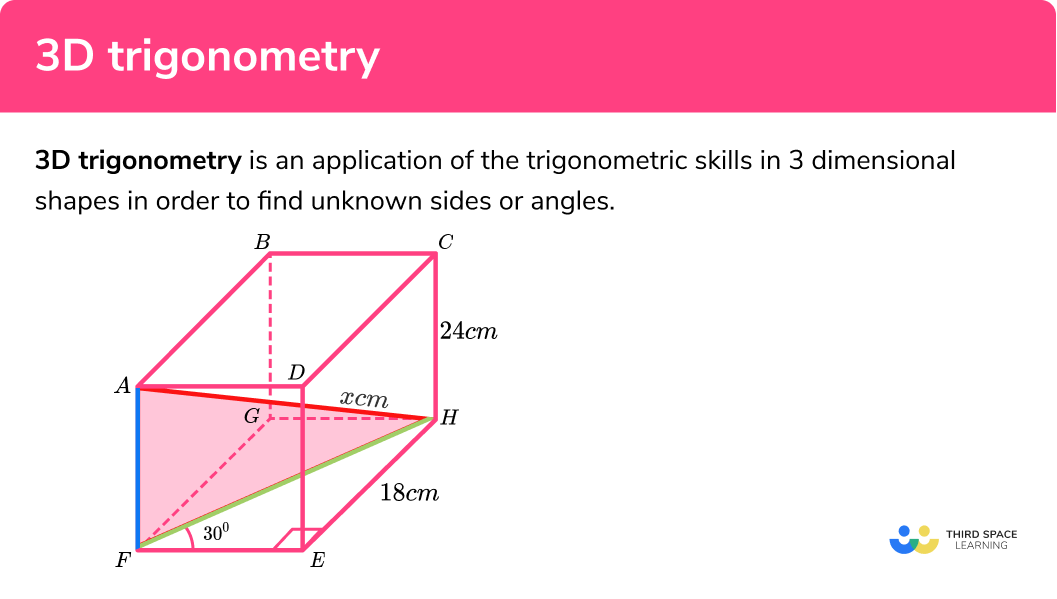
How to use 3D trigonometry to find a missing angle or side length
In order to find a missing angle or side within a
- Calculate the necessary missing angle or side of a triangle.
- Sketch and label the second triangle using information from Step
1 . - Calculate the missing angle or side of the final triangle.
Explain how to use 3D Trigonometry to find a missing angle or side length.
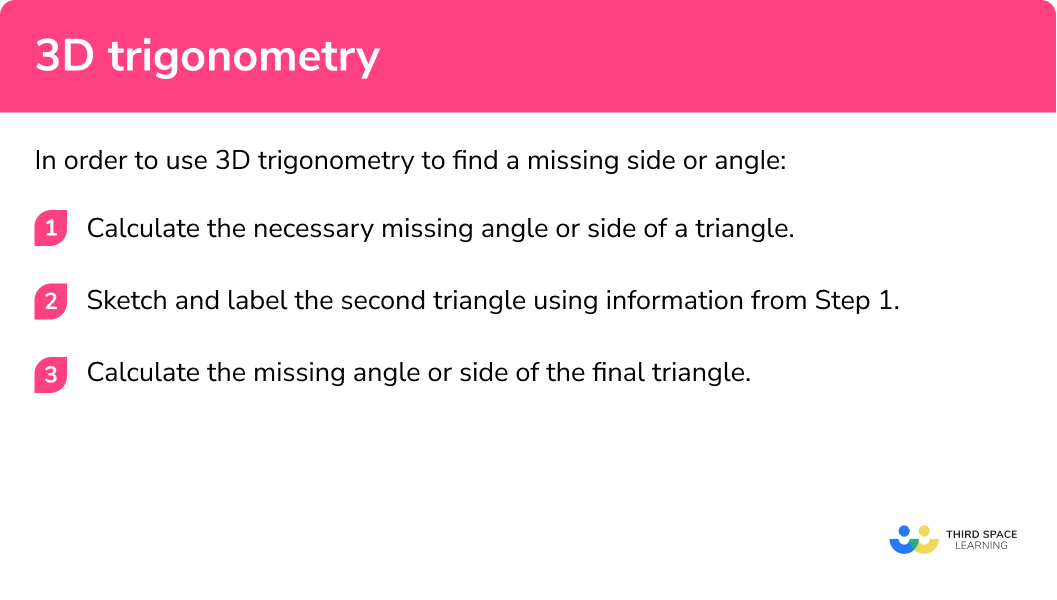
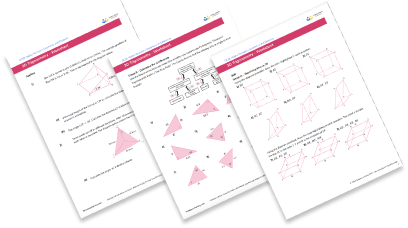
3D trigonometry worksheet

Get your free 3D trigonometry worksheet of 20+ questions and answers. Includes reasoning and applied questions.
DOWNLOAD FREE
3D trigonometry worksheet

Get your free 3D trigonometry worksheet of 20+ questions and answers. Includes reasoning and applied questions.
DOWNLOAD FREE3D trigonometry examples
Example 1: missing side using trigonometry and Pythagoras’ theorem
The diagram shows a cuboid.
Calculate the length of the line AH . Write your answer in the form a\sqrt{b}\mathrm{cm} where a and b are integers.
- Calculate the necessary missing angle or side of a triangle.
The line
Here we need to find the value of
2Sketch and label the second triangle using information from step 1.
3Calculate the missing angle or side of the final triangle.
See also: Hypotenuse
Example 2: finding length using trigonometric ratios
Calculate the necessary missing angle or side of a triangle.
The triangle
We need to find the value of
Sketch and label the second triangle using information from step 1.
You must remember not to round your solution too early. Here we will continue to use the full decimal given for
Calculate the missing angle or side of the final triangle.
Here we have a right angle triangle so we can use another trigonometric ratio to find the length
Example 3: missing angle including midpoint
- The front face of the cuboid is a square.
- The midpoint
M lies half-way betweenE andF . - The line
AC is at30o from the lineAB . BCM is a triangle.AC = 52cm - CE=26\sqrt{3}
Using the diagram below, calculate the size of angle
Calculate the necessary missing angle or side of a triangle.
The line
Here we need to find the value of
Sketch and label the second triangle using information from step 1.
As
Calculate the missing angle or side of the final triangle.
As we can split an isosceles triangle into two right-angle triangles, and we can use trigonometric ratios to find the angle \frac{\theta}{2} then multiply by 2 to find \theta :
Example 4: missing angle using the cosine rule
Calculate the necessary missing angle or side of a triangle.
Each side of the triangle
Here we need to find the value of
Here we need to find the value of
Here we need to find the value of
Sketch and label the second triangle using information from step 1.
Keeping BH=\sqrt{106} , we now have the triangle
Calculate the missing angle or side of the final triangle.
As we know the three side lengths of the triangle, we can use the cosine rule to find the missing angle \theta.
Example 5: missing angle using the sine rule
The diagram shows a triangular prism.
- Angle
DEC = 50º - Angle
EBC = 55º AE = AD
The angle
Calculate the necessary missing angle or side of a triangle.
The line
Here we need to find the value of
Sketch and label the second triangle using information from step 1.
Calculate the missing angle or side of the final triangle.
We know two sides and one of the two opposite angles so we need to use the sine rule to find the value for
Example 6: missing side using the sine rule
The diagram shows a cylinder:
A, B andD are points on the circumference of the circles.C is the centre of the circle.ABC is a triangleAD is the diameter of the cylinder.
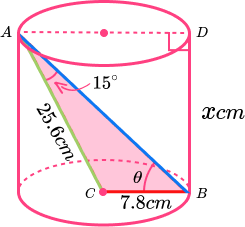
By calculating the size of angle \theta , work out the height of the cylinder.
Calculate the necessary missing angle or side of a triangle.
As we know two sides and one of the two opposite angles, we can use the sine rule to find the missing angle \theta .
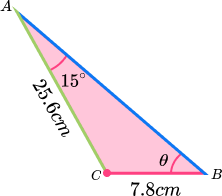
Here we need to find the value of \theta :
\begin{aligned} \sin(\theta)&=\cfrac{\sin(15)}{7.8}\times{25.6} \\\\ \theta&=\sin^{-1}(0.8494573788) \\\\ \theta&=58.15269987… \\\\ \theta&=58.2^{\circ} \; (2dp) \end{aligned}
Sketch and label the second triangle using information from step 1.
As
As the angle
We now have enough information on the second triangle to calculate the height of the cylinder. Remember not to round too early.
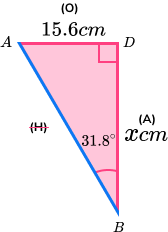
Calculate the missing angle or side of the final triangle
To find the value of
Common misconceptions
- Using Pythagoras’ Theorem instead of trigonometry
Using two sides of a non right-angle triangle to find the third side instead of using the cosine rule.
- Incorrect trigonometric ratio used
Incorrect labelling of any triangle can lead to the wrong trig function being used.
- Confusing the Sine Rule with the Cosine Rule
Misunderstanding when to use the sine rule or cosine rule to find a missing side or angle.
- Using the inverse trig function instead and inducing a mathematical error
If the inverse trig function is used instead of the standard trig function, the calculator may return a maths error as the solution does not exist.
Related lessons
3D trigonometry is part of our series of lessons to support revision on trigonometry. You may find it helpful to start with the main trigonometry lesson for a summary of what to expect, or use the step by step guides below for further detail on individual topics. Other lessons in this series include:
Practice 3D trigonometry questions
1. ABCDEFGH is a cuboid. Calculate the length of DF to 2 decimal places.
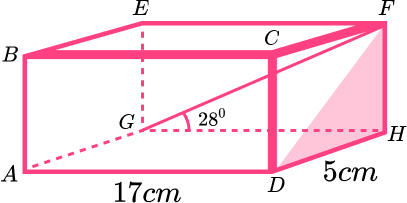




Let’s first look at triangle FGH:
We want to know the length of FH which is the opposite.
\begin{aligned} O&=A \tan(\theta)\\\\ O&=17 \tan(28)\\\\ O&=9.039060338 \mathrm{cm} \end{aligned}
Now that we know the length of FH , we can consider the triangle DFH:
Since we know two sides and we want to calculate the third side, we can use Pythagoras Theorem:
\begin{aligned}
c^{2}&=a^{2}+b^{2}\\\\
c^{2}&=5^{2}+9.039060338^{2}\\\\
c^{2}&=106.7046118\\\\
c&=\sqrt{106.7046118}\\\\
c&=10.33 \mathrm{cm}
\end{aligned}
2. ABCDEF is a triangular prism. Calculate the angle DAE . Give your answer to 1 dp.




First we need to look at the triangle DEF:
We need to find the length of DE , which is the opposite.
\begin{aligned} O&=H \sin(\theta)\\\\ O&=9sin(62)\\\\ O&=7.946528336 \mathrm{cm} \end{aligned}
Now that we know the length of DE, we can consider the triangle ADE :
We want to find the angle DAE. We know O and A .
\begin{aligned} \tan(\theta)&=\frac{O}{A}\\\\ \tan(\theta)&=\frac{7.946528336}{11}\\\\ \theta&=\tan^{-1}(\frac{7.946528336}{11})\\\\ \theta&=35.8^{\circ} \end{aligned}
3. ABCDE is a square based pyramid. By finding the value of x , calculate the perimeter of the base of the pyramid, correct to 2 decimal places.
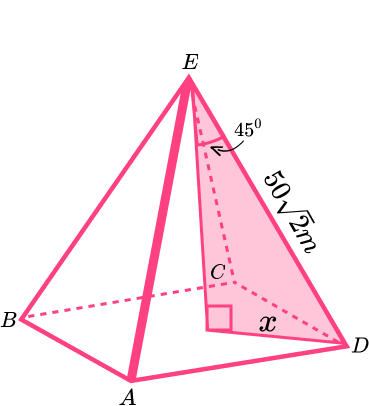




First we need to work out the value of x:
\begin{aligned} O&= H \sin(\theta)\\\\ O&=50 \sqrt{2} \sin(45)\\\\ O &=50 \mathrm{m} \end{aligned}
Now we can look at the base:
The length of the sides can be found using Pythagoras Theorem:
\begin{aligned} &c^2=a^2+b^2\\\\ &c^2=50^2+50^2\\\\ &c^2=5000\\\\ &c=70.71m \end{aligned}
Each side is 70.71m therefore the perimeter is:
4 \times 70.71=282.84 \mathrm{m}4. Three satellites leave Earth on three different trajectories. 2 hours after launch, satellite A is 800km from Earth, satellite B is 500km from Earth and satellite C is 750km from Earth.
Use the cosine rule to calculate the size of angle CAB at this point in time.




AB, AC and BC can all be worked out using Pythagoras Theorem:
\begin{aligned} &AB^2=500^2+800^2\\ &AB^2=890000\\ &AB=943.3981132\\\\ &AC^2=750^2+800^2\\ &AC^2=1202500\\ &AC=1096.58561\\\\ &BC^2=500^2+750^2\\ &BC^2=812500\\ &BC=901.388189\\ \end{aligned}
We can then apply the cosine rule:
The length of the sides can be found using Pythagoras Theorem:
\begin{aligned} \cos(A)&=\frac{b^{2}+c^{2}-a^{2}}{2bc}\\\\ \cos(A)&=\frac{1096.58561^{2}+943.3981132^{2}-901.388189^{2}}{2 \times 1096.58562 \times 943.3981132}\\\\ \cos(A)&=0.6186459892\\\\ A&=\cos^{-1}(0.6186459892)\\\\ A&=51.87^{\circ} \end{aligned}
5. Given that GH=10cm, work out the size of the angle GEH . Give your answer to 1 dp.




First we need to calculate the length of EH. We can do this using Pythagoras Theorem:
\begin{aligned} a^{2}&=c^{2}-b^{2}\\\\ a^{2}&=20^{2}-12^{2}\\\\ a^{2}&=256\\\\ a&=16 \mathrm{cm} \end{aligned}
We can now look at the triangle EGH:
We can calculate angle GEH using the sine rule:
\begin{aligned} \frac{\sin(A)}{a} &= \frac{sin(B)}{b}\\\\ \frac{\sin(\theta)}{10} &= \frac{sin(85)}{16}\\\\ \sin(\theta)&= \frac{sin(85)}{16} \times 10\\\\ \sin(\theta)&= 0.6226216863\\\\ \theta&= \sin^{-1}(0.6226216863)\\\\ \theta&=38.5^{\circ} \end{aligned}
6. ABCDEF is a triangular prism. X, Y, and Z are midpoints on each edge of the prism and triangle XYZ is isosceles. Using this information and the diagram to help you, calculate the size of angle XYZ.




We need to calculate the length XZ using the triangle CXZ:
\begin{aligned} O&=A \tan(\theta)\\\\ O&=5 \tan(76)\\\\ O&=20.05390467 \mathrm{cm} \end{aligned}
We can now look at triangle XYZ:
Using the cosine rule:
\begin{aligned} \cos(A) &= \frac{b^{2}+c^{2}-a^{2}}{2bc}\\\\ \cos(\theta)&= \frac{32^{2}+32^{2}-20.05390467^{2}}{2 \times 32 \times 32}\\\\ \cos(\theta)&=0.8036332556\\\\ \theta&= \cos^{-1}(0.8036332556)\\\\ \theta&=36.5^{\circ} \end{aligned}
3D Trigonometry GCSE questions
1. ABCDEFGH is a cuboid.
Calculate the angle between the diagonal DF and the base AEHD .
Give your answer to 3 sf.
(4 marks)
Triangle ADE:
DE^{2}=8^{2}+12^{2}
(1)
\begin{aligned} DE&=\sqrt{208}\\\\ DE&=14.4222\mathrm{cm} \end{aligned}
(1)
Triangle DEF:
\tan(\theta)=\frac{8}{14.4222}
(1)
\begin{aligned} \theta&=\tan^{-1}(\frac{8}{14.4222})\\\\ \theta&=29.0^{\circ} \end{aligned}
(1)
2. ABCDEF is a triangular prism.
The cross-section of the prism is an isosceles triangle.
M is the midpoint of AC .
Calculate the length of EM .
(4 marks)
(1)
\begin{aligned} 4.5\tan(70)&=x\\\\ 12.364&=x \end{aligned}
(1)
\begin{aligned} EM^{2}&=16^{2}+12.364^{2}\\\\ EM^{2}&=408.868 \end{aligned}
(1)
\begin{aligned} EM&=\sqrt{408.868}\\\\ EM&=20.2\mathrm{cm} \end{aligned}
(1)
3. Find the size of the angle AFH .
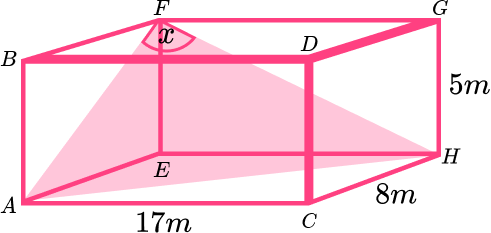
(6 marks)
(1)
\begin{aligned} FH^{2}&=17^{2}+5^{2}\\\\ FH&=17.720 \end{aligned}
(1)
\begin{aligned} AH^{2}&=17^{2}+8^{2}\\\\ AH&=18.788 \end{aligned}
(1)
\cos(x)=\frac{9.434^{2}+17.720^{2}-18.788^{2}}{2\times9.434\times17.720}
(1)
\cos(x)=0.1096
(1)
\begin{aligned} x&=\cos^{-1}(0.1496)\\\\ x&=81.4^{\circ} \end{aligned}
(1)
Learning checklist
You have now learned how to:
-
Apply Pythagoras’ Theorem and trigonometric ratios to find angles and lengths in right-angled triangles (and, where possible, general triangles) in 2 (and 3) dimensional figures
The next lessons are
Still stuck?
Prepare your KS4 students for maths GCSEs success with Third Space Learning. Weekly online one to one GCSE maths revision lessons delivered by expert maths tutors.

Find out more about our GCSE maths tuition programme.